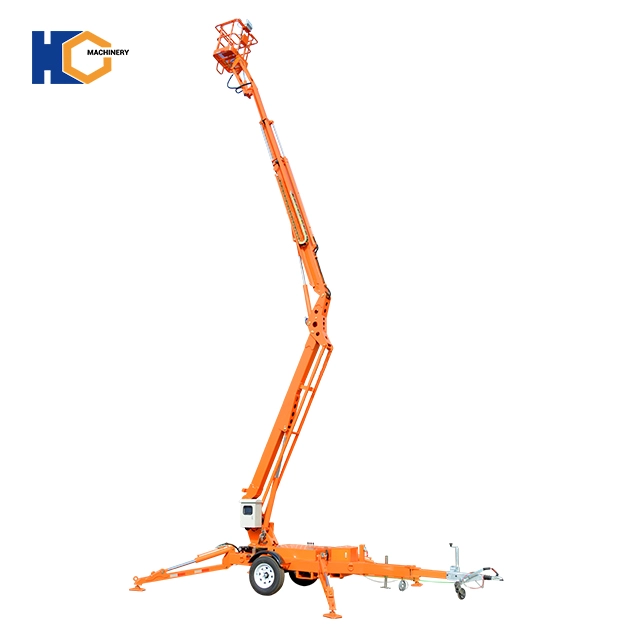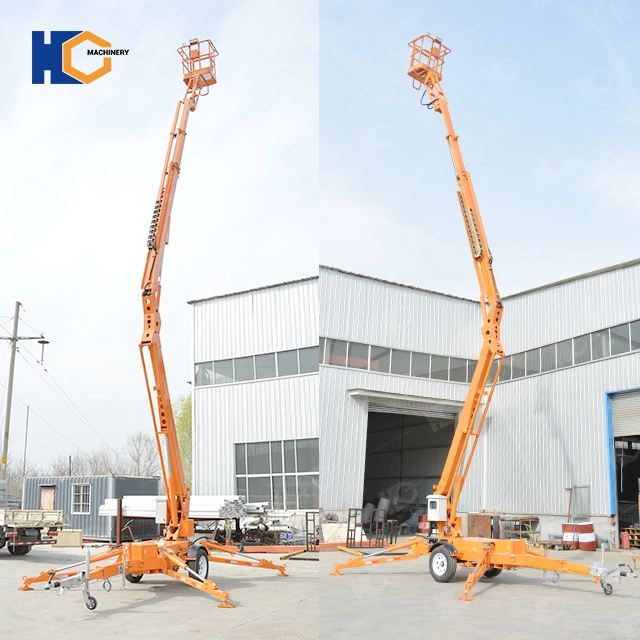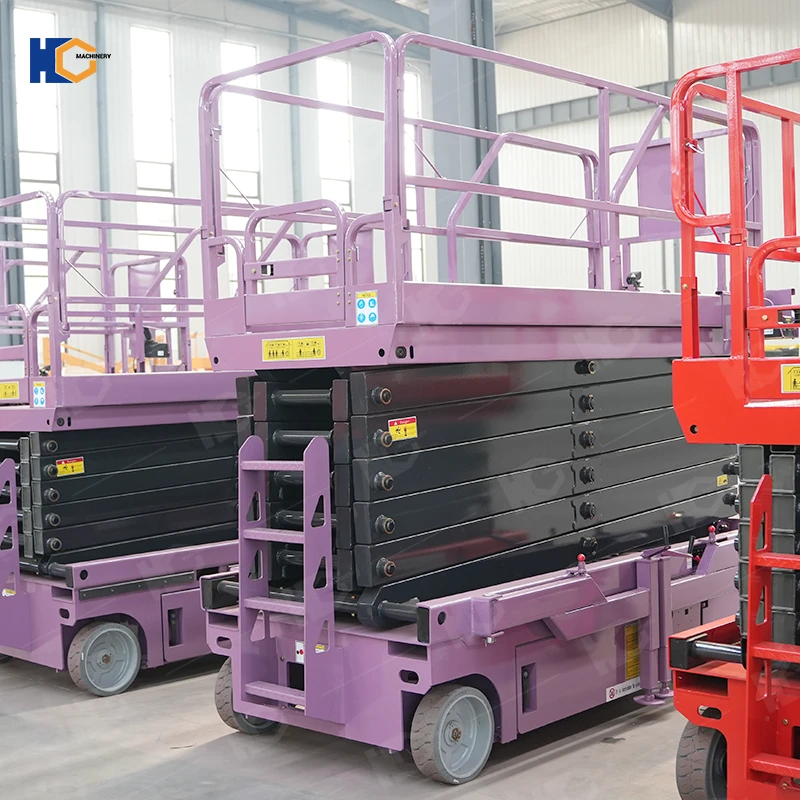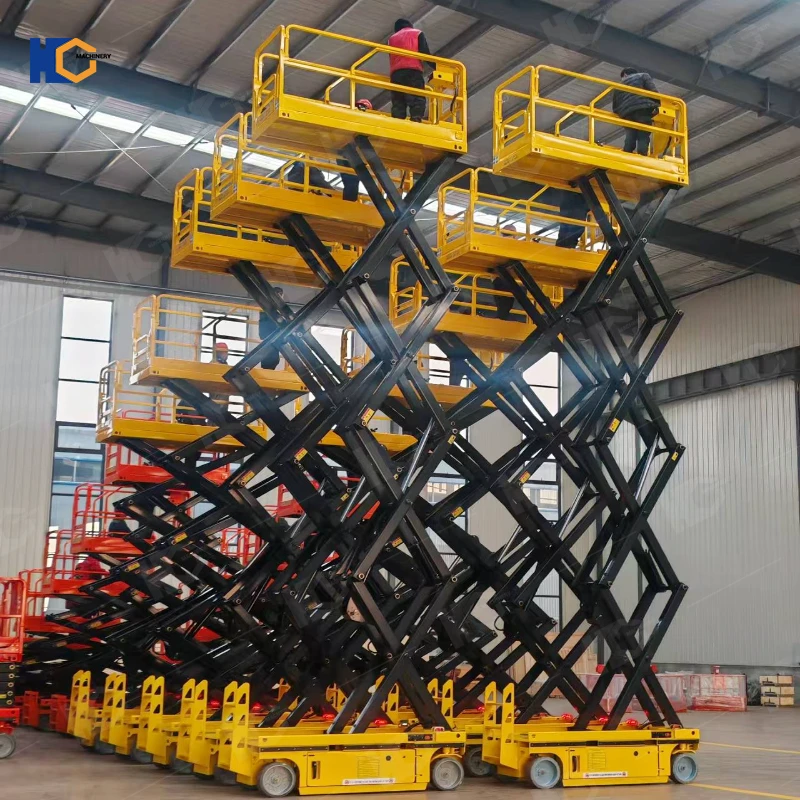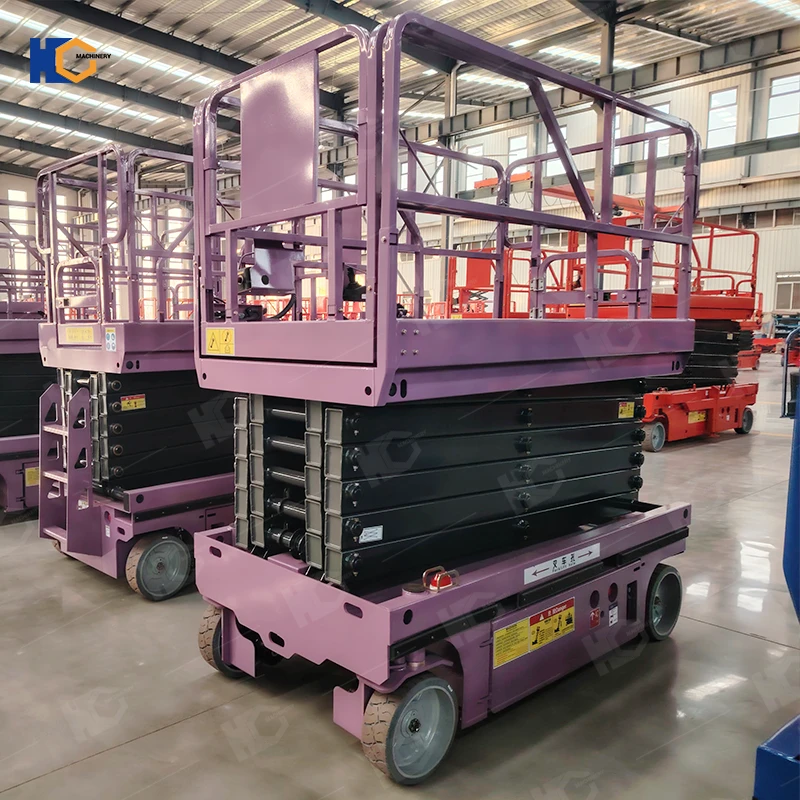![]() HC lift Price List-Boom Lift (2).pdf
HC lift Price List-Boom Lift (2).pdf
Articulating Boom Lifts
Design and Functionality:Articulating boom lifts feature multiple jointed sections, allowing the boom to bend or "articulate" at various points. This design enables the lift to maneuver around obstacles and reach confined spaces that are difficult to access with a straight boom lift.
Key Features:
Versatility: The articulated sections provide greater flexibility, making it easier to work in complex environments.
Obstacle Clearance: The boom can reach over and around obstacles, ideal for tasks that require precision placement.
Compact Storage: When retracted, the articulated sections make the lift more compact, facilitating easier transportation and storage.
Performance Data:
Maximum Working Height: Typically ranges from 30 feet (9 meters) to 150 feet (45 meters).
Horizontal Reach: Can extend up to 80 feet (24 meters) depending on the model.
Platform Capacity: Generally supports weights between 500 to 1,000 pounds (225 to 450 kilograms).
Applications:
Construction sites with obstructions like beams and pipes.
Maintenance tasks in industrial facilities with tight spaces.
Tree trimming and landscaping where precise positioning is required.
Real picture
Straight Boom Lifts
Design and Functionality:Straight boom lifts, or telescopic boom lifts, have a single, straight arm that extends telescopically. This design allows for a direct, unobstructed reach, providing a high degree of stability and reach.
Key Features:
Long Reach: The straight arm offers maximum horizontal and vertical reach, suitable for tasks requiring extensive coverage.
Simplicity: The straightforward design makes it easy to operate and maintain.
Stability: The single-arm structure provides enhanced stability, especially when fully extended.
Performance Data:
Maximum Working Height: Typically ranges from 40 feet (12 meters) to 180 feet (55 meters).
Horizontal Reach: Can extend up to 90 feet (27 meters), depending on the model.
Platform Capacity: Generally supports weights between 500 to 1,000 pounds (225 to 450 kilograms).
Applications:
High-rise building construction and maintenance.
Electrical and lighting installations on tall structures.
Industrial and warehouse operations requiring extensive reach.
Comparative Analysis
Maneuverability:
Articulating Boom Lifts: Superior maneuverability due to the jointed sections, making them ideal for environments with many obstacles.
Straight Boom Lifts: Limited maneuverability compared to articulating models, but their long, direct reach is advantageous in open spaces.
Reach:
Articulating Boom Lifts: Offer excellent vertical reach and can navigate around obstacles.
Straight Boom Lifts: Provide the longest horizontal reach, making them suitable for high and distant access points.
Stability:
Articulating Boom Lifts: Slightly less stable when fully extended due to the multiple joints.
Straight Boom Lifts: More stable due to the single, solid arm structure.
Cost:
Articulating Boom Lifts: Generally more expensive due to the complex design and additional articulation points.
Straight Boom Lifts: Typically more affordable and cost-effective for projects requiring long, unobstructed reach.
Choosing between an articulating boom lift and a straight boom lift depends on the specific requirements of the job. Articulating boom lifts are ideal for projects that demand flexibility and the ability to navigate around obstacles. In contrast, straight boom lifts are better suited for tasks requiring maximum horizontal and vertical reach in open spaces. Understanding the distinct features and performance data of each type ensures the selection of the most appropriate equipment, enhancing efficiency and safety on the job site.
Articulating Boom Lift vs. Straight Boom Lift: Pros and Cons
Boom lifts are essential for various industries that require elevated work platforms, such as construction, maintenance, and warehousing. Among the most popular types of boom lifts are articulating boom lifts and straight boom lifts (also known as telescopic boom lifts). Each type has unique advantages and disadvantages that make them suitable for different tasks. This article will explore the pros and cons of articulating boom lifts and straight boom lifts, supported by specific data to help make an informed decision.
Articulating Boom Lifts
Pros:
Maneuverability:
Articulating boom lifts have multiple jointed sections, allowing the boom to bend and reach around obstacles.
This feature makes them highly maneuverable and ideal for complex environments.
Example: A typical articulating boom lift can reach over and around obstacles up to 80 feet (24 meters) horizontally.
Versatility:
The ability to articulate at various points enables these lifts to access tight and confined spaces.
They are well-suited for indoor and outdoor use.
Example: Articulating boom lifts can work at heights ranging from 30 feet (9 meters) to 150 feet (45 meters).
Compact Storage:
When retracted, the articulated sections make the lift more compact for easier transportation and storage.
This feature is beneficial for worksites with limited storage space.
Cons:
Cost:
Articulating boom lifts are generally more expensive than straight boom lifts due to their complex design and additional articulation points.
Example: The initial purchase cost and maintenance expenses can be significantly higher.
Stability:
The multiple joints can make the lift slightly less stable, especially when fully extended.
Operators must be cautious of weight limits and movement to maintain safety.
Example: Platform capacities typically range from 500 to 1,000 pounds (225 to 450 kilograms), and stability can be compromised if overloaded.
Speed:
Articulating boom lifts may take longer to position precisely due to their jointed sections.
This can be a drawback in time-sensitive projects.
Straight Boom Lifts
Pros:
Long Reach:
Straight boom lifts, with their single, telescopic arm, provide a direct and unobstructed reach.
They are perfect for tasks requiring extensive horizontal and vertical coverage.
Example: These lifts can reach heights of 40 feet (12 meters) to 180 feet (55 meters) and horizontal distances up to 90 feet (27 meters).
Simplicity:
The straightforward design makes these lifts easy to operate and maintain.
Example: Operators often find them less complicated to maneuver, leading to quicker task completion.
Stability:
The single-arm structure provides enhanced stability, especially when fully extended.
Example: This stability is crucial for tasks that require precision and safety at great heights.
Cost-Effective:
Straight boom lifts are generally more affordable compared to articulating boom lifts.
They offer a cost-effective solution for projects that do not require intricate maneuverability.
Example: Lower initial purchase and maintenance costs make them a popular choice for budget-conscious projects.
Cons:
Limited Maneuverability:
The single, straight arm design limits the ability to maneuver around obstacles.
They are less suitable for confined or complex environments.
Example: Tasks requiring access to tight spaces or navigation around barriers may be challenging.
Size:
When fully retracted, straight boom lifts can be longer and more cumbersome to transport and store.
Example: The longer retracted length may pose logistical challenges in tight workspaces or during transport.
Versatility:
Straight boom lifts are less versatile than their articulating counterparts.
They are best suited for open spaces where direct reach is required.
Comparative Analysis
Performance Data:
Articulating Boom Lifts:
Maximum Working Height: 30-150 feet (9-45 meters)
Horizontal Reach: Up to 80 feet (24 meters)
Platform Capacity: 500-1,000 pounds (225-450 kilograms)
Straight Boom Lifts:
Maximum Working Height: 40-180 feet (12-55 meters)
Horizontal Reach: Up to 90 feet (27 meters)
Platform Capacity: 500-1,000 pounds (225-450 kilograms)
Choosing between an articulating boom lift and a straight boom lift depends on the specific requirements of the job. Articulating boom lifts offer superior maneuverability and versatility, making them ideal for complex environments with obstacles. In contrast, straight boom lifts provide long reach, stability, and cost-effectiveness, making them suitable for tasks requiring extensive coverage in open spaces. Understanding the pros and cons of each type, supported by performance data, ensures the selection of the most appropriate equipment for enhanced efficiency and safety on the job site.
Choosing the Right Boom Lift for Different Scenarios
Selecting the appropriate boom lift depends on the specific requirements of the task and the environment in which the lift will be used. Here's a guide on when to choose an articulating boom lift versus a straight boom lift, along with examples to illustrate each scenario.
Articulating Boom Lifts: Ideal Scenarios
1. Complex Environments with Obstacles:
Scenario: Construction sites with numerous obstacles such as beams, pipes, or other structural elements.
Example: A construction worker needs to install lighting fixtures in a newly built warehouse. The warehouse has multiple beams and supports that obstruct direct paths. An articulating boom lift allows the worker to maneuver around these obstacles and position themselves precisely where needed.
2. Indoor Maintenance Tasks:
Scenario: Maintenance activities in industrial facilities or commercial buildings where space is limited.
Example: An HVAC technician needs to service air conditioning units in a factory with a crowded layout. The technician can use an articulating boom lift to navigate around machinery and reach the units, ensuring efficient and safe maintenance.
3. Tree Trimming and Landscaping:
Scenario: Tasks that require reaching over and around trees or other landscape features.
Example: A landscaping team is tasked with trimming trees in a park with densely packed vegetation. An articulating boom lift allows them to reach over branches and trim the trees without damaging the surrounding flora.
4. Confined Spaces:
Scenario: Jobs in areas with restricted access or tight quarters.
Example: A utility worker needs to repair electrical lines in an alleyway between buildings. The articulating boom lift can extend and bend to provide access to the lines without requiring extensive space to maneuver.
Straight Boom Lifts: Ideal Scenarios
1. High-Rise Construction:
Scenario: Projects that require reaching significant heights in open areas.
Example: Workers are installing glass panels on a high-rise building. The straight boom lift provides the necessary height and stability to reach the top floors, ensuring efficient and safe installation.
2. Electrical and Lighting Installations:
Scenario: Installing or maintaining electrical lines or lighting systems on tall poles or structures.
Example: An electrician needs to replace bulbs on streetlights along a highway. The straight boom lift's long, unobstructed reach allows the electrician to access the lights quickly and efficiently, covering a large area without repositioning frequently.
3. Industrial and Warehouse Operations:
Scenario: Tasks that require extensive horizontal and vertical reach in open spaces.
Example: Workers in a large warehouse need to access storage racks at various heights. A straight boom lift provides the necessary reach and stability to move between racks and retrieve or store items efficiently.
4. Outdoor Construction Projects:
Scenario: Large-scale construction projects with minimal obstructions.
Example: A construction team is working on a bridge, requiring access to high points on the structure. The straight boom lift offers the long reach needed to cover the span of the bridge, ensuring all areas are accessible.
Choosing between an articulating boom lift and a straight boom lift depends on the specific requirements of the job and the environment. Articulating boom lifts are ideal for complex environments with obstacles, indoor maintenance, tree trimming, and confined spaces. In contrast, straight boom lifts are better suited for high-rise construction, electrical and lighting installations, industrial operations, and large outdoor projects. Understanding the strengths and limitations of each type of boom lift ensures that the right equipment is used for enhanced efficiency and safety.
About JNHC Lift
JNHC Lift is a renowned manufacturer specializing in the production of high-quality articulating boom lifts and straight boom lifts. With a commitment to innovation and safety, JNHC Lift provides versatile and reliable lifting solutions for a wide range of industries, including construction, maintenance, and industrial applications.
Our articulating boom lifts are designed for maximum maneuverability, allowing operators to navigate around obstacles and access confined spaces with ease. These lifts are perfect for complex environments and tasks that require precise positioning.
Our straight boom lifts offer exceptional reach and stability, making them ideal for projects that demand extensive vertical and horizontal reach. These lifts are widely used in high-rise construction, electrical installations, and large-scale industrial operations.
At JNHC Lift, we prioritize customer satisfaction by delivering robust, efficient, and safe lifting equipment. Our products are engineered to meet the highest standards, ensuring optimal performance and reliability on every job site. Choose JNHC Lift for your lifting needs and experience the difference in quality and service.
